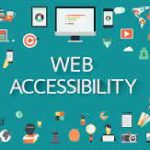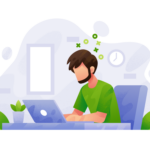The World Health Organization has assessed that about 15% of the world, about one billion people, has some sort of disability. Dyslexia is one of the most common forms of learning challenge affecting about a tenth of the population. Some forms of dyslexia lead to print disabilities, hampering the uptake of classroom education, leave alone the challenges of remote learning.
In a post-pandemic world, the education industry has been one of the fastest adopters of learning management systems. In a classroom, physical access was the largest stumbling block for knowledge dissemination to begin with, but with the rapid adoption of LMS, there is a remote possibility of it becoming a tool for creating a level ground. A properly designed learning management system (LMS) can provide the foundational framework to make that possible. Digitized curriculums, virtual classrooms, AI-based real-time student assessments, automated assignment tracking and attendance management, hyper-personalized content, and format are a few requirements facilitated by LMS software.
Considering the high incidence of print-disabled citizens in the general population, the chances that you’ll have at least one disabled learner in every training group is very high. And as a training professional, it’s your responsibility to ensure that everyone experiences education & training in a positive, accessible, and engaging way. The solution? Create accessible learning management for an inclusive and equitable experience.
The Section 508 Standards for Electronic & Information Technology was legislated as an amendment to the United States Rehabilitation Act of 1973 in 2000 by the then president of United States H W Bush. The recent EU web accessibility directive made it mandatory for all the public websites & apps within the geography of Europe to meet the W3C’s Web Content Accessibility Guidelines (WCAG) guidelines. Both of these standards have always served as a statutory stimulus for faster migration to accommodate everyone online.
While there is a range of LMS products available in the market, educational institutions need to choose ‘the one’ that is holistic, customizable, and most important of all, Accessible! Either the choice can be to buy an off-the-shelf (OTS) product that is accessible, in which case your existing investment becomes useless or the alternative is to integrate it with an accessibility compliance product.
A holistic approach to the integrated solution for LMS design ensures that all aspects of student learning are accommodated. Customization makes the software better suited for your institution’s needs to deliver personalized content. But it is accessibility that facilitates learning for students with diverse kinds of needs. The success of an LMS depends on how well a student comprehends, understands, and receives the content delivered through the software. Accessibility is the key to delivering that success! The digital platform should be easily intuitive for regular readers and print-disabled alike!
In designing applications & apps, sometimes the experience of end-users is assumed and never actually collated and used to design a suitable UI or incorporate a functionality. Our design team spoke to many print-disabled students currently attending classrooms remotely for their feedback. Their feedback will surely help designers and product owners in academic institutions decide when choosing the LMS suitable for their educational institution. We have collated six of the major suggestions that can transform your online education experience and make them accessible & inclusive.
codemantra’s Accessible LMS Solution
codemantra believes ‘accessibility’ promotes comprehensive student learning. Every new release of our Content Assembly Platform ensures an ongoing refinement of the built-in accessibility features. Our products are not only WCAG 2.1 AA compliant, but they are also integrated with loads of AI features that keep them up to the standards with the latest trends of accessibility.
codemantra’s Content Assembly Platform is designed to work with any learning management/delivery solution across operating system stacks. The application complements your existing LMS to make all your courseware accessible.
At codemantra, we also support educators in converting all their content into fully accessible content across any file type like image, text, audio-video & hyperlinks. Educators can leverage the native text editors of codemantra solutions to evaluate the accessibility attributes of their digitized content.
- Fixed text/font size in pixels on web pages is increasingly becoming outdated. First, it pixelates based on device sizes. Second, not all students are uniformly sighted to read small fonts (Some may need to zoom in to enlarge font sizes). Fixed-size fonts also are typically non-responsive, resulting in adjacent hyperlink text being too close even for normal consumers. EM and percentages are great choices to auto-stretch your text fonts according to device sizes. Hence, try to replace your webpage or LMS style-sheets font-sizes in EM’s or percentages instead of Pixels.
- Not all LMS users will see colors the same way. It would be better to avoid using multi-spectral text colors on the webpage in the best interest of those who are color-challenged. Statistically, color blindness affects approximately 1 in 12 men (8%) and 1 in 200 women worldwide.
- Foreground and background tests need to adhere to 1.4.3 of WCAG. Contrast your colors, more specifically for small text fonts. Online accessibility color checker is a great tool to validate if the choice of colors will work for everyone. The aim for having the right contrast is to read by people with moderately low vision without the use of contrast-enhancing assistive technology.
- Screen Readers or Assistive technologies can better decode LMS content that has a navigable hierarchical structure. So, try to tag your course content with heading tags. Using H2, H3, H4 tags in order of topic’s importance within the context of the article is a great way to add semanticity to your content. The greater the hierarchical semanticity, the better your LMS content’s accessibility! and performance in assistive devices.

- Links should be descriptive and explicit to the extent possible. The link should hint users of the additional information available on the webpage linked to the text. It will help screen reading widgets read aloud the relevant link texts in a meaningful way to the users and give the right context to the content.
- A non-sighted user will be able to make an informed choice of navigating on the links if the text on the link is descriptive rather than generic call-to-actions. ‘Click Here’ can be replaced by ‘Click here to know more about (the subject),’ ‘Sign-up can be replaced by ‘click here to purchase our yearly plans’
- At all costs, avoid entering a raw URL as link text, for it will be incoherent to hear random alphanumeric codes for users who rely on screen readers or assistive technologies to access your site.
- Make it a practice to provide ‘alt’ text for all the images you provide on the software. This requirement can be skipped only when the images are provided for aesthetic purposes.
- The ‘alt’ text would ideally be a short description of the content displayed on the image. The text should be precise for users. If your image description is longer than ten words, try to use ‘image captions or descriptions’ instead. Captions and description boxes are a great way to provide detailed information about your images.
- It would be worthwhile to repeat text from Images with quotes and text.
- codemantra LMS’s default media player has in-built accessibility features that showcase on-screen user controls and device compatibility. Please take advantage of these default multimedia settings while using codemantra LMS.
- It is necessary to provide closed captions (CC) or subtitles to your multimedia content to make them consumable by the print-disabled.
- Not everyone can see a video, alike. So, as much as possible, provide transcripts. It will help you scheme the multimedia content in accessibility-friendly alternative formats.
- Tables need to be restricted to represent tabular data only.
- It is a good practice to provide table captions to hint to users about the table contents. The choice to read or skip the table can be possible only if table captions are provided.
- Use Row and Column headers can make tabular information more illustrative. Tabular information will be delivered to users with greater clarity using row and column headers. So, try to include headers on your tables.
Note: codemantra’s aI platform can syntactically give alt-text to tables and give content to rows and columns.
- It might be easier to upload images of equations than to type them out as equations themselves. But, please be aware: An Image is an Image! ‘Alt’ text on an image may not give a full understanding of the mathematical information provided on the equations.
- Equations need to retain their mathematical formats for them to be accessible and better comprehendible for print-disabled students.
- So, try to use widgets like MathML, Atto editors, Mathjax, or even MS-Word equation builder to present equations as equations. These widgets can help you draft equations with proper syntax that can be accessible to all students.
Note: codemantra’s alt-text can tag elements within individual rows and columns.
These six elements can help you evaluate the accessibility standing of your online educational programs. If you need support in transforming your online education towards becoming accessible, reach out to us at email-id.
codemantra LMS can help your school build a learning ecosystem that accommodates student diversity and promote inclusivity at the same time. To learn more about accessibility, contact our codemantra team today!
codemantra LMS can help your school build a learning ecosystem that accommodates student diversity and promote inclusivity at the same time. To learn more about how to make your curriculum accessible, contact codemantra team today at info@codemantra.com






